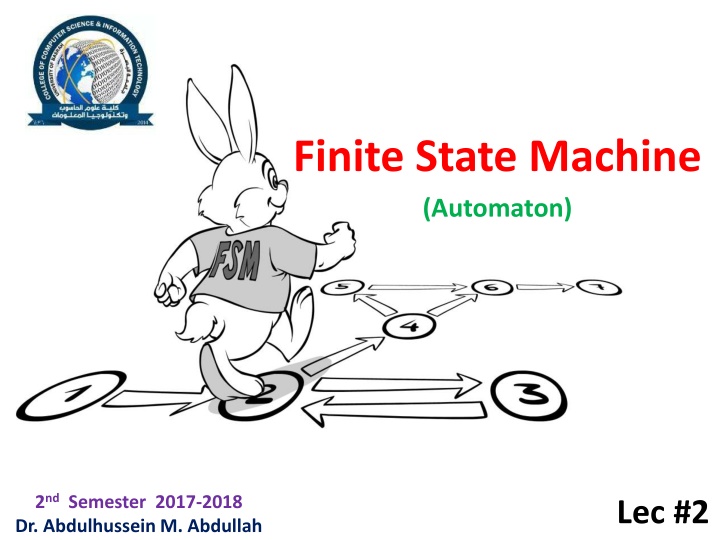
Finite State Machines in Computer Science
Explore the concept of finite state machines (automata) and their role as abstract models of computation. Learn how automata process input strings and transition through states to determine acceptance or rejection. Discover why state machines are essential for simplifying complex systems in computer science.
Download Presentation

Please find below an Image/Link to download the presentation.
The content on the website is provided AS IS for your information and personal use only. It may not be sold, licensed, or shared on other websites without obtaining consent from the author. If you encounter any issues during the download, it is possible that the publisher has removed the file from their server.
You are allowed to download the files provided on this website for personal or commercial use, subject to the condition that they are used lawfully. All files are the property of their respective owners.
The content on the website is provided AS IS for your information and personal use only. It may not be sold, licensed, or shared on other websites without obtaining consent from the author.
E N D
Presentation Transcript
Finite State Machine (Automaton) 2ndSemester 2017-2018 Dr. Abdulhussein M. Abdullah Lec #2
Automaton An input string is placed on the tape (left-justified). Input Tape Start State Finite Control
How does a Automaton work? An input string is placed on the tape (left- justified). Automata begins in the start state. Head placed on leftmost cell.
Automata goes into a loop until the entire string is read. In each step, Automata consults a transition table and changes state based on (s, ) where s - current state - symbol scanned by head After reading input string, if Automata state final, input accepted if Automata state not final, input rejected
Machine view of FA input tape 0 1 1 0 0 1 1 1 0 1 0 0 1 0 1 q0 finite control
Machine view of FA input tape 0 1 1 0 0 1 1 1 0 1 0 0 1 0 1 q3 finite control
Machine view of FA input tape 0 1 1 0 0 1 1 1 0 1 0 0 1 0 1 q1 finite control
Machine view of FA input tape 0 1 1 0 0 1 1 1 0 1 0 0 1 0 1 q2 finite control etc
Why State Machines? Goal: provide simple abstractions of complex systems All computer systems are state machines > registers and memory are state > changes are transitions between states > a program defines the way in which initial states are transformed into final states > a programming language determines a set of programs (and hence, a set of machines)
Primary challenge will be to represent these very complex machines with simpler (more abstract) machines that we can reason about Essence of modeling is choosing those characteristics to model and those to abstract away from
State Machines Are Used When it is possible to abstract away irrelevant details, leaving only a small number of states When we want to examine every possibility using model checking For communication protocols and complex distributed algorithms (e.g., cache coherency)
Informally .. A state machine captures the idea that a system progresses through a set of states by performing (or responding to) a set of actions Thus there are two key concepts > States > Actions
Characteristics A state machine definition must say > what the possible states are > what initial states the machine may start in > what the possible actions are > how the state changes when actions occur
What is a State? A snapshot of the system > values of memory, registers Set of values for variables > snapshot of running program s data Control location(s) > snapshot of where a program is in its execution sequence(s) Contents of communication channels > snapshot of a communication state
Automata can be categorized based on control: A deterministic automaton(DFA) has a unique next state from the current configuration. A nondeterministic automaton (NDFA)has several possible next states.
Automata can also be categorized based on output: An accepter has only yes/no output. A transducer has strings or symbols for output,
FA diagrams (single) start state alphabet = {0,1} 0,1 1 states 0 (several) accept states transition for each symbol 0,1 read input one symbol at a time; follow arrows; accept if end in accept state
FA operation Example of FA operation: input: 01 0 1 0,1 1 not accepted 0 0,1
FA operation Example of FA operation: input: 10 1 0,1 1 accepted What language does this FA recognize? 0 L = {x : x {0,1}*, x1= 1} 0,1
Example FA 0 1 0 even odd 1 What language does this FA recognize? L = {x : x {0,1}*, x has even # of 1s} illustrates fundamental feature/limitation of FA: tiny memory in this example only remembers 1 bit of info.
A deterministic finite automaton (DFA) is a quintuple M = (K, , , s, F) where K is a finite set of states; is an finite alphabet, s K is the initial state, F K is the set of final states, is the transition function from K x K (p, a) = q
A language of an FA, M, L(M) is the set of Language words (strings) that accepts. If La = L(M), we say that M recognizes La . If La is recognized by some finite automaton FA , La is a Regular Language.
Q: How do you prove that a language La is regular? A: By presenting an FA, M , satisfying La = L(M).
Simple Example States: {alarm} Actions: {beep} Initial state: {alarm}
Example States: {off, idle, moving, crashed} Actions: {key, gas, brake} Initial state: {off}

